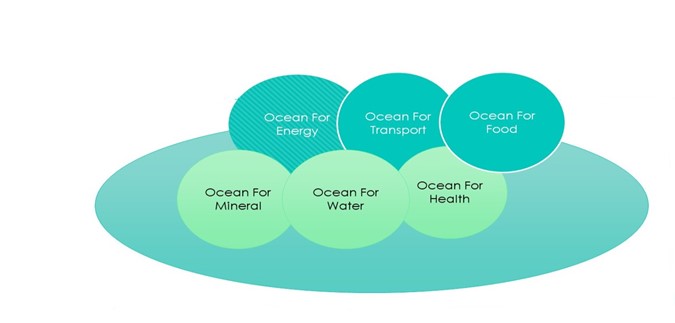What is Blue Economy?
The Blue Economy conceptualizes oceans and seas as “Development Spaces” where spatial planning integrates conservation, sustainable use of living resources, oil and mineral wealth extraction from the seabed, bioprospecting, sustainable energy production, and marine transport.[1]In layman’s terms, it encompasses all the activities of the economy that transpires directly or indirectly at seas and the oceans, or centering seas and oceans as well as the coastal waters. Contrary to predominant previous practices that have been around for so long which focused on resource extraction and financial benefits, Blue Economy tries to strike a balance between extraction of benefits and maintaining the resource supply.[2]
Prospects of Blue Economy for Bangladesh in Comparison with the World:
Bangladesh has a 710 km long coastline with an exclusive economic zone of 200 Nautical Miles inside the Bay of Bengal. Following the settlement of its maritime dispute with neighboring India and Myanmar, Bangladesh has now acquired 118,813 km2 of the territorial sea, 200 nautical miles of Exclusive Economic Zone (EEZ), and a substantial share of the extended continental shelf.[3]
China is the world’s 2nd largest economy and enrooted to become the first economy by 2028 has seen a massive rise of coastal economic transaction. The total production value of China’s maritime economy increased from RMB 1068 billion in 2002 to a staggering RMB 7761 billion in 2017, contributing to about 10 percent of China’s total gross domestic product. The procedure of economic valuation to identify the worth of ocean-based industries to national economies has been particularly embraced in China since 1996.[4] In Europe the blue economy represents roughly 5.4 million jobs and generating a gross added value of almost €500 billion a year, playing a vital role in the continent’s GDP. Underlining the blue economy as an untapped source for fueling sustainable development the Prime Minister expressed her resolve to turn the Bay of Bengal into a hub of economic development and prosperity in the First International Workshop on Blue Economy in 2014 held in Bangladesh.[5]
With lucid and visionary planning Bangladesh can build infrastructure that is unparallel to any other sectors. Economic Experts opined that if Bangladesh utilizes its marine resources actively and sustainably, it can be a middle-income country within a short period.[6]
Sectors of Blue Economy:
Twenty-six maritime economic functions have been identified by the government of Bangladesh from among the fishery, maritime trade and shipping, energy, tourism, coastal protection, maritime safety, and surveillance for the development of the blue economy in Bangladesh. These functions include Coastal shipping/Feeder services, Seaports, Passenger ferry services, Inland waterway transport, Shipbuilding, Ship recycling industries, Fishery, Aquaculture, and Mariculture, Marine aquatic products, Marine Biotechnology, Energy Extraction namely oil and gas, Sea salt production, Ocean renewable energy such as wind, wave and tidal range and currents offer a significant potential to contribute to low-carbon energy supplies for regions with appropriate coastal features; Blue energy (osmosis) and biomass, Aggregates mining (sand, gravel, etc.), Marine genetic resource, Tourism Coastal tourism,Recreational water sports, Yachting and Marinas, Cruise tourism, Coastal protection/Artificial islands/Greening coastal belts, Coastal protection: Artificial islands, Maritime safety, and surveillance.[7]
Planning and Materialization of Blue Economy:
Foreign Minister Dr. AK Abdul Momen stated, “Bangladesh considers the blue economy as one of the cornerstones for its economic growth and socio-economic development,” in an international webinar titled “Blue Economy in Post-Covid-19 Era: Resilience Strategies for the Coastal States” that was convened by Bangabandhu Sheikh Mujibur Rahman Maritime University(BSMRMU).[8]To better coordinate Blue Economy initiatives across sectoral ministries, the government in 2017, formed the “Blue Economy Cell’ under the Ministry of Foreign Affairs (MoFA), following the recommendation of the Planning Ministry. The Shipping Ministry has created a work plan to accommodate the Blue Economy goal of the government consolidating the sectors of tourism, container freight, and port management. To persevere domestic innovation for exploring the potentials of Blue Economy the Bangladesh Oceanographic Research Institute (BORI) and Bangladesh Institute of Maritime Research and Development (BIMRAD) have been established for the creation of a marine scientific community in the country.
Challenges of materialization of Blue Dream:
While it is true that the Bay of Bengal holds a great
source of wealth and means of sustainable growth for the country, the harsh
reality is that we lack the necessary skilled manpower to seek this lofty
Dream. Though the government swiftly mobilized to capitalize on the resources
it obtained through the international dispute settlements, years of negligence
have created a vacuum. However, the best way to ensure sustainable exploitation
of the ocean economy would be to first formulate planning then integrate the
planning sparsely after gaining experience through the execution of spatial
ministerial planning.
[1] Rear Admiral Md. KhurshedAlam (Retd.), BLUE ECONOMY –DEVELOPMENT OF SEA RESOURCES FOR BANGLADESH, <https://mofa.gov.bd/site/page/8c5b2a3f-9873-4f27-8761-2737db83c2ec/OCEAN/BLUE-ECONOMY–FOR-BANGLADESH#:~:text=The%20objective%20of%20the%20Blue,and%20long-term%20time%20frames> accessed on 27th February, 2021.
[2]Moutusi Islam and Lam-yaMostaque, ‘Blue Economy and Bangladesh: Lessons and Policy Implications’ (2016) 2 Economics 1.
[3] Md Shahidul Hasan, “Maritime Verdicts and Resource Exploration for Bangladesh”, BIISS Journal, Vol. 35,
No. 3, July 2014, p. 227.
[4] Alistair McIlgorm, “Ocean Economy Valuation Studies in the Asia-Pacific Region: Lessons for the Future
International Use of National Accounts in the Blue Economy”, Journal of Ocean and Coastal Economics, Vol.
2, No. 2, 2016, p. 10.
[5]Supra note, 1.
[6] Md. Monjur Hasan, B. M. Sajjad Hossain, Md. JobaerAlam, K. M. Azam Chowdhury, Ahmad Al Karim,
Nuruddin Md. Khaled Chowdhury, “The Prospects of Blue Economy to Promote Bangladesh into a Middle-
Income Country”, Open Journal of Marine Science, Vol. 8, 2018, p. 355-369.
[7]Supra note, 1.
[8] ‘Work plan prepared to tap into potential of blue economy’, The Daily Star, <https://www.thedailystar.net/city/news/work-plan-prepared-tap-potential-blue-economy-2009561>, accessed on 1st Marchh, 2021.


